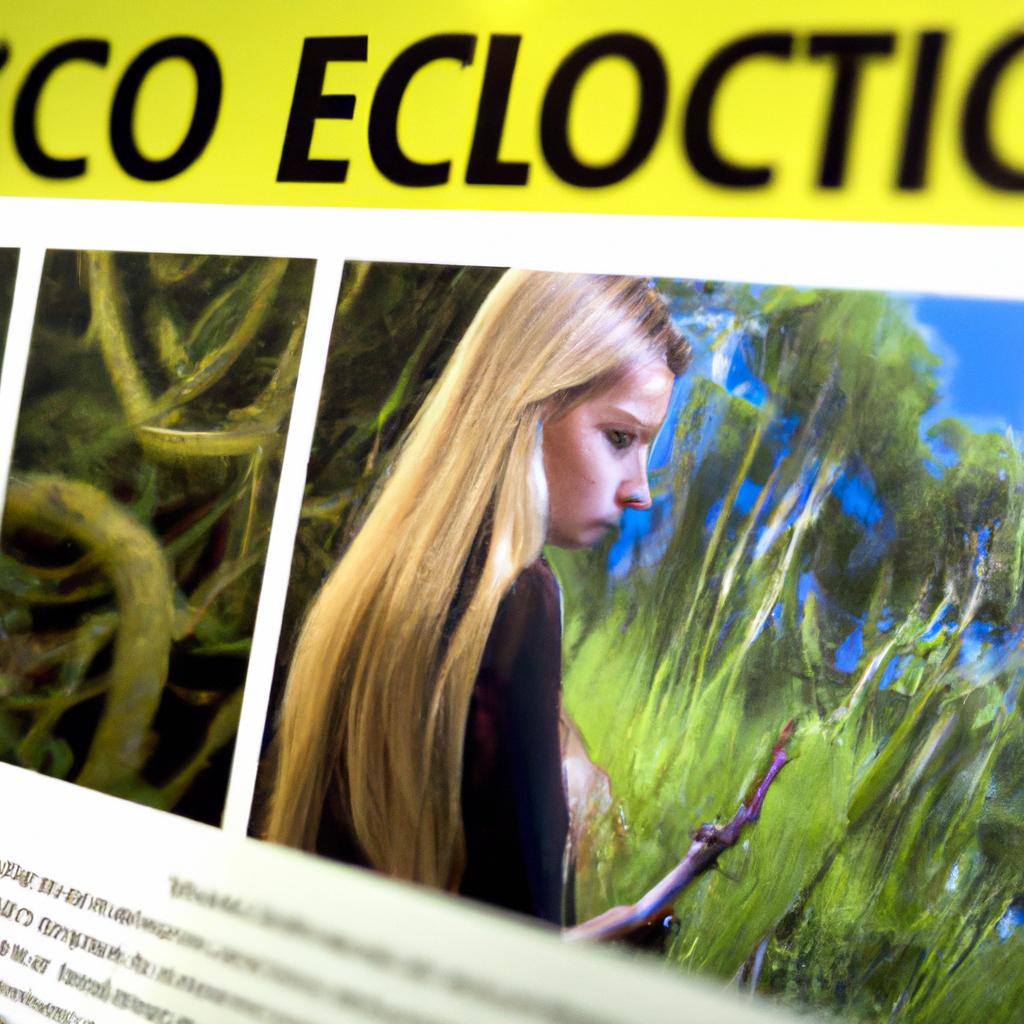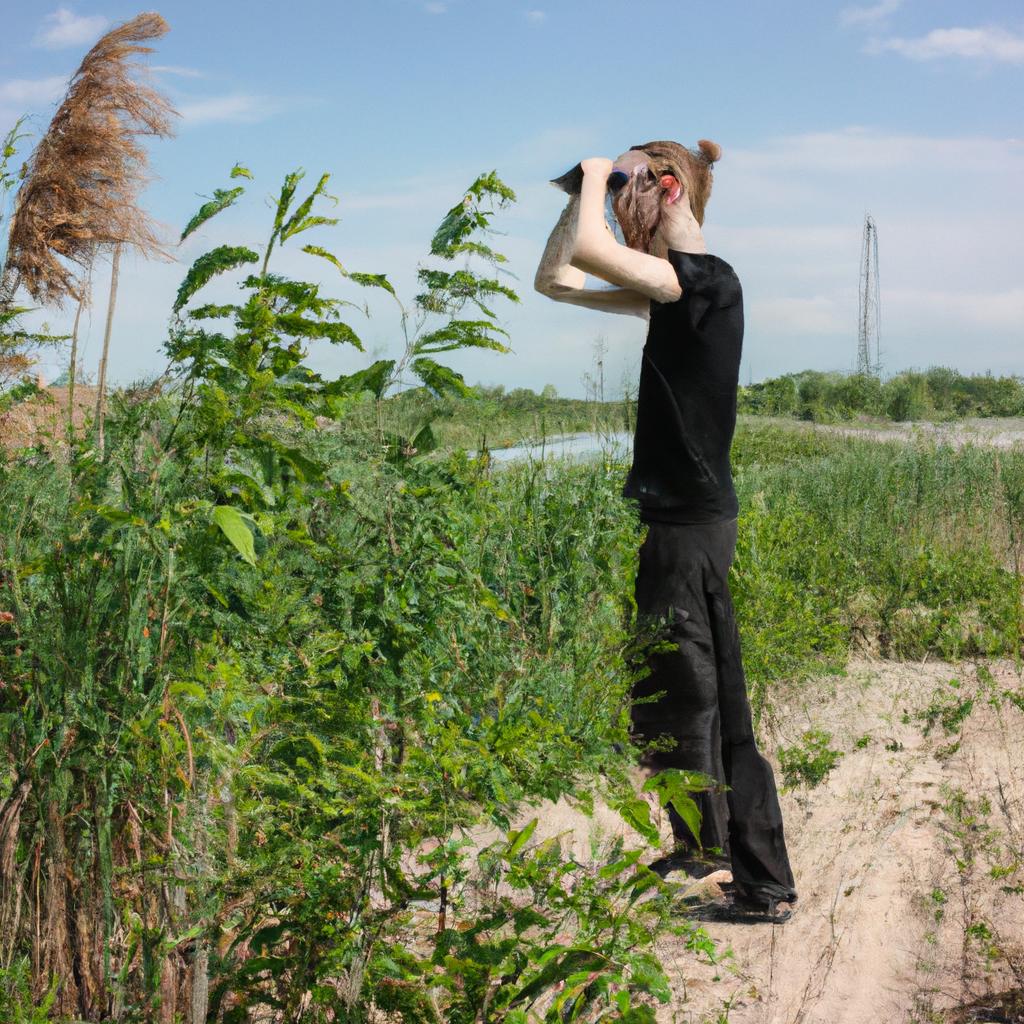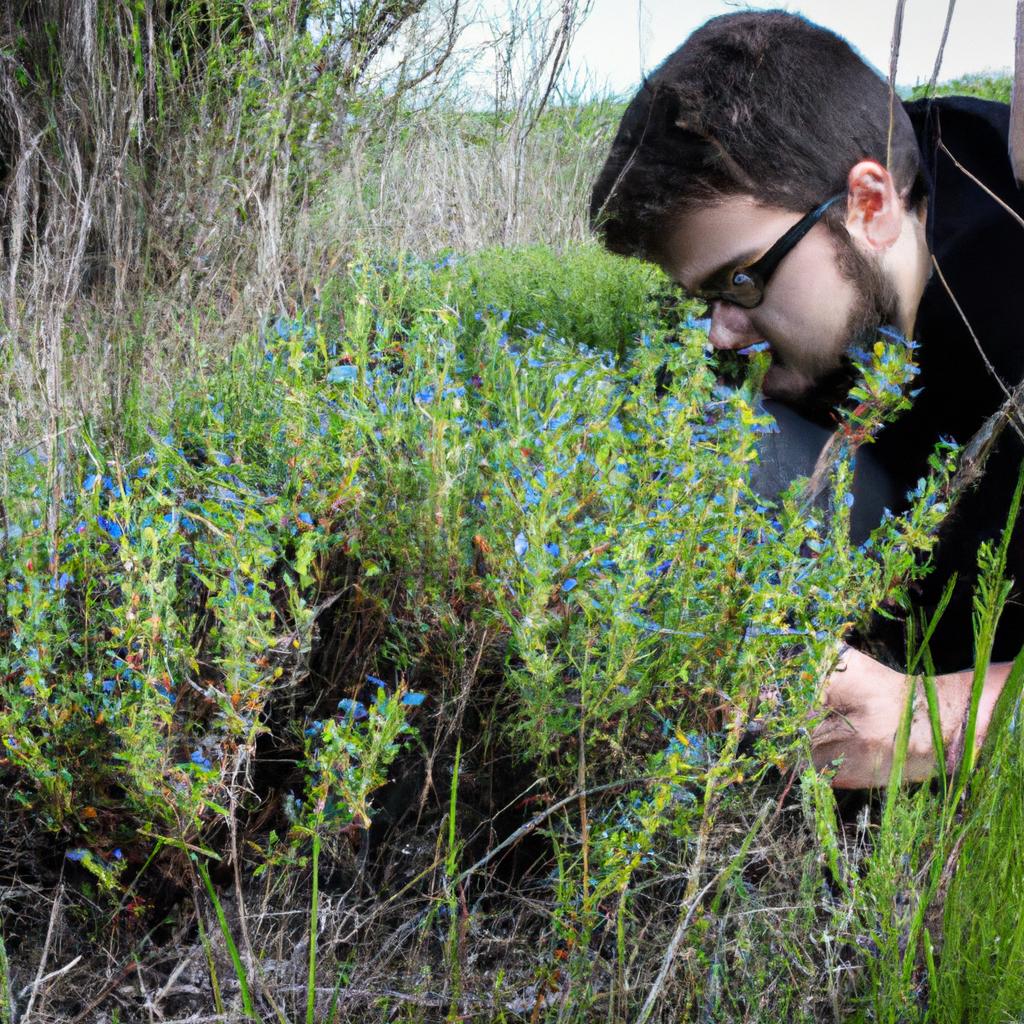Population Dynamics: The Interplay of Science, Biology, and Ecology

Population dynamics, the study of how populations change over time, is a complex field that lies at the intersection of science, biology, and ecology. It seeks to understand the intricate interplay between various factors influencing population size, distribution, growth rates, and interactions with their environment. By examining the dynamic nature of populations through rigorous scientific methods and employing mathematical models, researchers can unravel underlying mechanisms and predict future trends. For instance, consider a hypothetical scenario where a small island ecosystem experiences an influx of an invasive species. The subsequent impact on native flora and fauna would trigger a cascade effect throughout the food web, ultimately leading to drastic changes in population sizes for multiple species.
The study of population dynamics incorporates principles from diverse disciplines such as genetics, evolutionary biology, demography, and community ecology. Scientists rely heavily on empirical data collected from field studies or obtained from long-term monitoring programs to analyze patterns and make informed predictions about population dynamics. Mathematical models play a crucial role in this process by providing a framework to simulate different scenarios and test theoretical assumptions against real-world observations. These models integrate biological processes like birth rates, death rates, migration patterns, genetic variation within populations with environmental variables such as resource availability and climate conditions. Through these interdisciplinary approaches, scientists strive to uncover fundamental insights about population dynamics and contribute to the broader understanding of how ecosystems function and evolve.
By studying population dynamics, researchers can gain valuable insights into topics such as species interactions, conservation strategies, disease spread, and the impacts of human activities on natural systems. This knowledge is crucial for making informed decisions about ecological management and conservation efforts.
Population dynamics studies also have practical applications in fields like agriculture, fisheries, and public health. For example, understanding the population dynamics of pests can help farmers implement effective pest control measures. Similarly, studying the dynamics of disease-causing organisms can aid in developing strategies to prevent or control outbreaks.
In summary, population dynamics is a multidisciplinary field that combines scientific inquiry with mathematical modeling to understand how populations change over time. By examining factors such as birth rates, death rates, migration patterns, and environmental influences, researchers aim to unravel the complexities of population dynamics and their implications for ecosystems and human society.
Historical Perspective on Population Dynamics
Population dynamics is a field of study that examines the changes in population size, structure, and distribution over time. It encompasses various disciplines such as biology, ecology, and mathematics to understand the complex interplay between individuals, species, and their environment. By analyzing historical patterns and current trends, researchers can gain insights into how populations are influenced by factors like birth rates, death rates, migration, and environmental conditions.
One example that highlights the importance of studying population dynamics is the case of the North American gray wolf (Canis lupus). In the early 20th century, this keystone predator was nearly driven to extinction due to habitat loss and intensive hunting programs. However, through conservation efforts aimed at protecting its natural habitats and implementing regulations on hunting practices, the gray wolf population has rebounded in certain regions. This success story demonstrates how an understanding of population dynamics can inform effective management strategies for endangered species.
- Loss of biodiversity: Population decline or extinctions can disrupt ecosystems and lead to a loss of biodiversity.
- Impacts on food security: Changes in population sizes can affect food production systems and impact global food security.
- Disease outbreaks: Understanding population dynamics helps predict disease outbreaks among humans or wildlife populations.
- Climate change effects: Studying population dynamics aids in assessing how climate change impacts different species’ distributions.
Furthermore, incorporating a table using markdown format could visually illustrate data related to historic trends in human population growth across different continents:
| Continent | Year 1900 | Year 1950 | Year 2000 | Year 2021 |
|---|---|---|---|---|
| Africa | 133 | 229 | 811 | 1303 |
| Asia | 947 | 1402 | 3700 | 4644 |
| Europe | 408 | 547 | 726 | 746 |
| North America | 82 | 171 | 313 | 368 |
In conclusion, population dynamics provides a framework for understanding the intricate relationships between individuals, species, and their environment. By analyzing historical patterns, researchers can gain insights into how populations change over time. Factors such as birth rates, death rates, migration, and environmental conditions all play crucial roles in shaping population dynamics. In the subsequent section on “Factors Influencing Population Growth,” we will delve deeper into these specific factors and explore their impact on population trends.
Factors Influencing Population Growth
Population dynamics is a complex field that encompasses various scientific disciplines, including biology and ecology. Understanding the interplay between these disciplines is crucial for comprehending how populations change over time. In this section, we will explore the factors influencing population growth and delve into the intricate relationships that exist within ecosystems.
To illustrate the significance of population dynamics, let us consider an example: the reintroduction of gray wolves (Canis lupus) to Yellowstone National Park in 1995. Before their reintroduction, the park’s ecosystem experienced imbalances due to an absence of top predators. Elk populations soared, leading to overgrazing, which negatively impacted plant communities and other herbivore species. However, with the return of gray wolves, predation pressure on elk increased, resulting in reduced browsing intensity and subsequent vegetation recovery. This case study highlights how changes in one population can have cascading effects throughout an entire ecosystem.
Several key factors influence population growth:
- Birth rate: The number of offspring produced by individuals within a population affects its size. High birth rates lead to rapid population growth, while low birth rates result in slower expansion.
- Death rate: Mortality plays a significant role in determining population size. Factors such as predation, disease outbreaks, competition for resources, and environmental conditions can all impact death rates.
- Immigration: The arrival of individuals from other populations introduces new genetic diversity and can enhance or alter existing dynamics within a population.
- Emigration: Conversely, emigration refers to individuals leaving a population. It can affect both the source and destination populations by altering gene flow and changing available resources.
Table: Examples of Population Dynamics
| Factor | Positive Impact | Negative Impact |
|---|---|---|
| Birth Rate | Increased genetic diversity | Overpopulation |
| Death Rate | Maintains ecological balance | Decreased biodiversity |
| Immigration | Enhanced adaptation | Altered ecosystem dynamics |
| Emigration | Reduced competition | Genetic isolation |
These factors interact in complex ways, creating intricate webs of relationships within ecosystems. Understanding the interplay between birth rates, death rates, immigration, and emigration allows researchers to predict population trends and develop strategies for conservation efforts.
In the subsequent section on “Population Size and Distribution,” we will explore how these dynamic processes shape both the abundance and spatial arrangement of populations. By examining the underlying mechanisms that govern population dynamics, scientists can gain valuable insights into how organisms respond to their environment and adapt over time.
Population Size and Distribution
Population Dynamics: The Interplay of Science, Biology, and Ecology
Factors Influencing Population Growth have long been a subject of scientific inquiry. Understanding the intricate web of interactions that shape population dynamics is crucial for predicting changes in population size and distribution. Building upon this knowledge, we now delve into the concept of Population Size and Distribution to further explore how these factors play out in real-world scenarios.
Consider the case study of the gray wolf population in Yellowstone National Park. Wolves were reintroduced to the park in 1995 after being extirpated from the region for nearly 70 years. This reintroduction had profound effects on not only the wolf population but also on other species within the ecosystem. Gray wolves are keystone predators, meaning their presence or absence can significantly impact an entire ecological community. In Yellowstone, their return led to a cascade of effects such as regulating elk populations, restoring vegetation growth through reduced herbivory pressure, and even altering river courses due to increased beaver activity. This example highlights how changes in population size can trigger complex ecological processes with far-reaching consequences.
Several key factors influence population size and distribution:
- Availability of resources: Adequate food, water, shelter, and space determine carrying capacity—the maximum number of individuals an environment can sustain.
- Reproductive rate: The ability to reproduce successfully directly affects population growth potential.
- Environmental pressures: Natural disasters, climate change, habitat destruction—all these external forces exert selective pressures on populations.
- Dispersal patterns: Movement across landscapes allows gene flow between subpopulations and influences overall genetic diversity.
To illustrate the significance of these factors visually, let us consider a hypothetical scenario where a small island is inhabited by a bird species facing limited resources due to habitat fragmentation caused by human activities. We create a table below showcasing different aspects affecting its survival:
| Factors | Impact | Emotional Response |
|---|---|---|
| Resource scarcity | Struggle for survival | Concerned |
| Habitat loss | Decreased breeding opportunities | Worried |
| Predation | Increased vulnerability | Anxious |
| Climate change | Shifting nesting patterns | Apprehensive |
In summary, understanding population size and distribution extends beyond a simple headcount. It requires an examination of various factors that shape these dynamics. By considering case studies such as the gray wolf reintroduction in Yellowstone National Park and hypothetical scenarios like the bird species on a fragmented island, we gain valuable insights into how populations interact with their environment. This knowledge sets the stage for our next exploration: Population Interactions and Competition.
[Transition sentence]: With a grasp of population size and distribution, we can now delve into the intricate world of population interactions and competition, where individuals compete for limited resources within ecosystems.
Population Interactions and Competition
Building upon the understanding of population size and distribution, we now delve into the intricate web of population interactions and competition. Through examining these dynamics, we can gain valuable insights into the delicate balance that governs ecosystems and shapes the natural world.
Population Interactions:
To comprehend how populations interact with one another, let us consider a hypothetical scenario involving two species of birds – the Blue Jay and the Red Cardinal. In this case study, both bird species compete for limited resources such as food and nesting sites within their shared habitat. This competition drives adaptations in each species to exploit different niches or areas of specialization, reducing direct conflict between them.
- The struggle for survival intensifies as resources become scarce.
- Competition can lead to evolutionary changes over time.
- Cooperation between individuals may emerge to maximize collective benefits.
- Resource partitioning helps maintain ecological balance amidst intense competition.
Population Interactions Table:
| Interaction | Description | Example |
|---|---|---|
| Predation | One organism preys on another for sustenance | Lions hunting gazelles in African savannah |
| Mutualism | Both organisms benefit from their interaction | Bees pollinating flowers for nectar |
| Commensalism | One organism benefits while the other remains unaffected | Barnacles attaching themselves to whales |
| Amensalism | One organism is harmed while the other is neither benefited nor harmed | Black walnut trees secreting toxins |
Ecosystem Stability:
Understanding population interactions enables us to appreciate its crucial role in maintaining ecosystem stability. These interactions shape community structure by influencing factors like biodiversity, energy flow, and nutrient cycling. By studying complex webs of interdependence among various living organisms, scientists strive to unravel nature’s intricate mechanisms that foster equilibrium within ecosystems.
As we grasp the significance of population dynamics in shaping ecosystems’ stability, we now turn our attention to the broader concept of Population Dynamics and Ecosystem Stability. By exploring this interplay between populations and their environments, we can comprehend the intricate balance that underlies the natural world.
Please let me know if there’s anything else I can assist you with!
Population Dynamics and Ecosystem Stability
In the previous section, we explored how population interactions and competition play a crucial role in shaping ecosystems. Now, let us delve deeper into the fascinating world of population dynamics and its intricate relationship with ecosystem stability.
To illustrate this concept, consider the hypothetical case study of two species of birds competing for limited resources within a forested area. Species A is known for its ability to efficiently gather food, while species B has developed superior camouflage skills that allow it to evade predators more effectively. As both species rely on similar resources such as insects and berries, they compete intensely for these vital sustenance sources.
Understanding the complex dynamics at play between these bird populations requires examining several key factors:
- Resource availability: The abundance or scarcity of essential resources directly influences the intensity of competition among individuals within a population.
- Population size: The number of individuals within each species affects their ability to secure enough resources to meet their basic needs.
- Reproductive rates: The rate at which individuals reproduce determines the growth potential of each population and its capacity to outcompete others.
- Predation pressure: The presence or absence of natural predators can significantly impact population dynamics by altering competition levels among species.
These interrelated factors collectively contribute to an ever-changing equilibrium where one slight variation can have cascading effects throughout an entire ecosystem. To visualize the complexity of these relationships, consider the following table:
| Factors | Impact on Competition |
|---|---|
| High resource availability | Decreased competition |
| Large population size | Increased competition |
| Rapid reproductive rates | Intensified competition |
| Presence of predators | Altered competitive balance |
As ecological researchers continue to explore these intricacies, it becomes increasingly evident that even small perturbations within populations can lead to significant consequences for overall ecosystem stability. By comprehending these dynamic processes and their underlying principles, scientists strive to gain insights into mitigating potential disruptions caused by human activities.
In the subsequent section, we will delve into the impacts of human activities on population dynamics and explore how our actions can influence the delicate balance of ecosystems. By understanding these implications, we can work towards fostering a harmonious coexistence between nature and mankind.
Impacts of Human Activities on Population Dynamics
The Interplay of Science, Biology, and Ecology in Population Dynamics
Transition: Building upon the previous section’s exploration of population dynamics and ecosystem stability, this section delves into understanding the impacts human activities have on population dynamics.
Human activities can significantly influence population dynamics, often leading to changes that disrupt ecological balance. One example illustrating this interplay is the decline of honeybee populations worldwide. Honeybees play a crucial role in pollination, contributing to ecosystem stability and supporting agricultural productivity. However, various factors such as habitat loss, pesticide use, climate change, and diseases have led to significant declines in honeybee populations.
To grasp the broader implications of human activities on population dynamics, it is vital to understand their underlying causes. Several key factors contribute to these effects:
-
Habitat destruction: As humans continue to expand urban areas or clear land for agriculture and infrastructure development, natural habitats are destroyed or fragmented. This disruption affects numerous species by reducing available resources and limiting their ability to survive and reproduce.
-
Pollution: The release of harmful pollutants into air, water bodies, and soil has detrimental effects on both terrestrial and aquatic organisms. Chemical contaminants can accumulate within food chains or directly impact reproductive processes.
-
Overexploitation: Unsustainable practices such as overfishing or excessive hunting lead to declines in targeted populations beyond sustainable levels. These actions disrupt ecosystems’ delicate balance by removing key species from trophic interactions.
-
Climate change: Alterations in global temperature patterns affect ecosystems at multiple scales. Rising temperatures can shift species distributions or alter phenological events like migration timing or reproduction cycles.
| Factors Contributing to Human-Induced Population Changes |
|---|
| Habitat destruction |
| Pollution |
| Overexploitation |
| Climate change |
Understanding the complex relationships between science, biology, ecology, and human activities allows us to recognize our responsibility in mitigating negative impacts on population dynamics. By adopting sustainable practices, protecting natural habitats, reducing pollution, and promoting conservation efforts, we can help restore ecological balance and safeguard the intricate web of life on our planet.
Through a comprehensive understanding of population dynamics and its interplay with science, biology, and ecology, we can make informed decisions that promote long-term sustainability and ensure a healthy coexistence between humans and the natural world.








